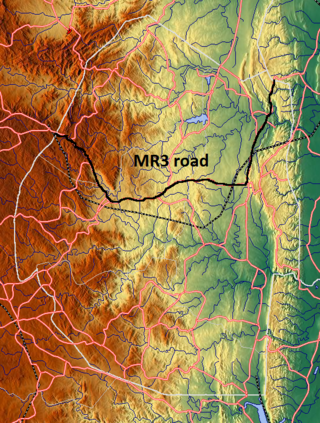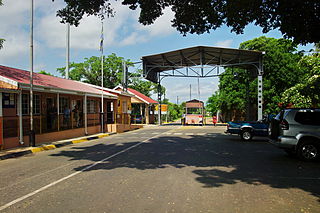Related Research Articles

Modes of transport in Mozambique include rail, road, water, and air. There are rail links serving principal cities and connecting the country with Malawi, Zimbabwe and South Africa. There are over 30,000 km of roads, but much of the network is unpaved.

Eswatini, officially the Kingdom of Eswatini and also known by its former official name Swaziland and formerly the Kingdom of Swaziland, is a landlocked country in Southern Africa. It is bordered by Mozambique to its northeast and South Africa to its north, west, south, and southeast. At no more than 200 km (120 mi) north to south and 130 km (81 mi) east to west, Eswatini is one of the smallest countries in Africa; despite this, its climate and topography are diverse, ranging from a cool and mountainous highveld to a hot and dry lowveld.

Eswatini, is a country in Southern Africa lying between Mozambique and South Africa. The country is located at the geographic coordinates 26°30′S31°30′E. Eswatini has an area of 17,363 square kilometres, of which 160 are water. The major regions of the country are Lowveld, Midveld and Highveld.
Public transport is the main means of transportation in Eswatini. Car ownership is low, at 89 cars per 1,000 people (2014). The National Road Network has 1500 km of main roads and 2270 km of district roads.

Mbabane is the most populous city in Eswatini, and is one of the two capitals, serving as the executive capital.

KwaZulu-Natal is a province of South Africa that was created in 1994 when the government merged the Zulu bantustan of KwaZulu and Natal Province.

Hhohho is a region of Eswatini, located in the north western part of the country. Hhohho was named after the capital of King Mswati II, who expanded the Swazi territory to the north and west, taking in the districts of Barberton, Nelspruit, Carolina and Piet Retief. These areas were later acquired by what was the Province of Transvaal and today they form part of the Mpumalanga Province of South Africa. It has an area of 3,625.17 km², a population of 320,651 (2017), and is divided into 14 tinkhundla. The administrative center is the national capital of Mbabane. It borders Lubombo Region on the southeast and Manzini Region in the southwest.

The Maputo River, also called Great Usutu River, Lusutfu River, or Suthu River, is a river in South Africa, Eswatini, and Mozambique. The name Suthu refers to Basotho people who lived near the source of the river, but were attacked and displaced by Swazis. It is also said to mean 'dark brown', a description of the river's muddy water.
Simunye is a sugar mill town on the lowveld in eastern Eswatini. Almost all of the residents of the town work for the Royal Eswatini Sugar Corporation's sugar mill located nearby.
Lubuli is a town in southeastern Eswatini (Swaziland). It is located close to the South African border just to the northwest of the town of Nsoko on the road between there and Maloma.
Golela is a border town straddling both Kwa-Zulu Natal Province, South Africa and Eswatini, east of Pongola and south of Lavumisa. The Golela border post was recently rebuilt to meet the increasing movement of people and goods between South Africa and Eswatini.

The MR3 road, also known as the Matsapha–Mbabane–Ngwenya road or Road No. MR3, is a major highway of Eswatini. It is one of the busiest roads in the country, crossing it from east to west. Along with the MR7 and MR8 roads, it forms the "backbone of Swaziland's internal transport system." It connects the EN5 road in Mozambique near Namaacha at 25°59′21″S31°59′53″E to the N17 road in South Africa at 26°12′45″S30°59′18″E, near Ngwenya. The road passes through Hlane Royal National Park and through the capital of Mbabane, about 110 kilometres (68 mi) further to the southwest. The highway descends into the Ezulwini Valley in four lanes. At Manzini, a bridge crosses the Mzimene River.

Jeppes Reef, is a small rural village on the R570 road in Ehlanzeni District Municipality in the Mpumalanga province of South Africa, 25 kilometres (16 mi) south-southeast of Kaapmuiden, and just over 2 kilometres (1.2 mi) from the border with Eswatini. It is just south of Schoemansdal.

The border between Mozambique and South Africa is divided into two segments, separated by the kingdom of Eswatini. The northern segment, which is 410 kilometres (255 mi) long, runs north–south along the Lebombo Mountains from Zimbabwe to Eswatini. The southern segment, which is 81 kilometres (50 mi) long, runs east–west across Maputaland from Eswatini to the Indian Ocean.

The border between Eswatini and South Africa is 430 kilometres (267 mi) long; South Africa surrounds Eswatini to the north, west, south and southeast, with Mozambique bordering it on the northeast.
Oshoek in Mpumalanga is the main border post between South Africa and Eswatini The N17 national road starts here. The area on the /Eswatini side of the border is known as Ngwenya, and the road leads directly to Mbabane, the Swazi capital city. The border is open between 07:00 and 00:00 local time daily.
Josefsdal is a border crossing between South Africa and Eswatini on the R40 road in Mpumalanga. The Eswatini side of the border post is known as Bulembu. The border is open between 08:00 and 16:00.
Waverley in Mpumalanga is a small border crossing between South Africa and Eswatini. The Eswatini side of the border post is known as Lundzi. The border is open between 08:00 and 16:00.
Mananga in Mpumalanga is a border post between South Africa and the north of Eswatini. The border is open between 07:00 and 18:00.
A series of protests in Eswatini against the absolute monarchy and for democratisation began in late June 2021. Starting as a peaceful protest on 20 June, they escalated after 25 June into violence and looting over the weekend when the government took a hardline stance against the demonstrations and prohibited the delivery of petitions. Lower-level unrest and protests continued until summer 2023.
References
- ↑ "South African Ports of entry". Archived from the original on 28 August 2015. Retrieved 22 August 2015.